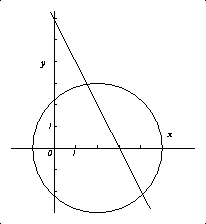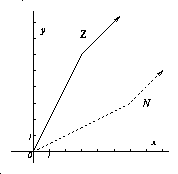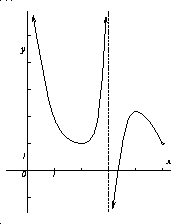The answers ...
Please read these answers after
you work on the problems. Reading the answers without working on the
problems is not a useful strategy!
Notation eFrog will be called exp(Frog) here, mostly
because it is easier to type and read. Also, sqrt(Toad) will denote
the square root of Toad (so sqrt(4) is 2).
Comment Answers will generally not be "simplified"
unnecessarily. It is the philosophy of the management that formulas
are delicate, and there is some risk of damaging them any time they
are touched, so ... unless you really need to change them, don't
bother.
Problem 1
B, the amplitude, is half of the difference between the maximum and
the minimum, so B=2. The vertical shift A is the average of the
maximum and minimum, so A= 7. Substituting x=0 will yield a value for
C: algebraically y = A+Bsin(0+C) = 7+2sin(C). But (0,7.6) seems to be
the y-intercept of the graph (at least approximately!) so that 7.6=
7+2sin(C). Solve this with your calculator (be sure to use radians!)
and .3 will be the approximate value of arcsin(.3).
TOP
Problem 2
The two triangles ABF and FDE are similar so pairs of corresponding
sides are proportional. In ABF, we choose the pair of sides AB and BF,
and in FDE, we choose the pair of sides FD and DE. Then 12/x=x/5, so
that x=sqrt(60). The hypotenuse AE can be obtained from the
Pythagorean Theorem: it is just
sqrt((12+sqrt(60))2+(5+sqrt(60))2), which is
approximately 22.834. There are many equivalent ways to write this
quantity, such as sqrt(289+34sqrt(60)) or
(sqrt(17))(2sqrt(3)+sqrt(5)). No, we don't expect you to notice
this: perhaps it would be best to just leave the answer alone, as it
was initially written! The angle theta can be found in various
ways. For example, the tangent of theta is (5+sqrt(60))/(12+sqrt(60)),
and therefore theta itself is approximately .573 radians.
TOP
Problem 3
a) The functions ln and exp are inverses. Also, 3 ln
(sqrt(x))= ln (x3/2), so exp(3 ln(sqrt(x)) ) = exp (ln
(x3/2))= x3/2.
b) The standard properties of logs will be used. ln(B2
sqrt(A)) = 2 ln(B) + (1/2) ln A = 2 (5.3) + (1/2) (1.2)= 11.2. For the
second part of the problem, we recall (look at the graph of ln!) that
ln(Frog) < ln(Toad) exactly when Frog < Toad. Therefore we can
compare A9 and B2 by comparing their lns. But
ln(A9) = 9 ln(A)= 9 (1.2) =10.8 and ln(B2)=2
ln(B) = 2 (5.3) = 10.6, so that the first number is larger than the
second.
TOP
 Problem 4 a) The equation of the circle is (x-2)2 +
y2 = 9.
Problem 4 a) The equation of the circle is (x-2)2 +
y2 = 9.
b)The equation of the line is y=-2x+6.
c) Maybe the easiest way is to substitute "y" from b) into the
equation in a). This yields a quadratic in x which can be solved using
the quadratic formula (important moral lesson: very few quadratics,
even with small integer coefficients, can be "solved" by factoring!).
The second coordinates can be gotten by using the equation in b). The
two points gotten are ((14+sqrt(41))/5, (2-2sqrt(41))/5) and
((14-sqrt(41))/5, (2+2sqrt(41))/5). These points are approximately
(1.52,-2.16) and (4.08,2.96). The picture may help some people
understand the answers.
TOP
 Problem 5 a) The graph of y=Z(x) in the accompanying figure is
the solid broken line.
Problem 5 a) The graph of y=Z(x) in the accompanying figure is
the solid broken line.
b) Since 2 is in the interval [0,3], Z(2) should be evaluated using
the first expression so Z(2) = 2*2 = 4. Since 4 belongs to the interval
[3,infinity), we evaluate Z(4) using the second expression: Z(4) = 4+3=7.
c) Z is strictly increasing so it has an inverse N. For x in [0,3],
Z(x)=2x, so the values of Z are in [0,6]. That means N(x) = (1/2)x for
x in [0,6] (just solve y=2x for x!). Otherwise (for x > 6) N(x)= x-3
(gotten by solving y=x+3 for x). To find N(2) we use the first
formula, so N(2)=(1/2)2=1, and N(8) uses the second formula, so
N(8)=5.
d) The graph of y=N(x) in the accompanying figure is
the dashed broken line.
TOP
Problem 6
The inverse function is given by n(p) =
((p-100)/3)2 and its domain coincides with the range of
p(n) which is [103,130]. n(p) represents the number of boxes of
detergent which can be produced for p dollars in this model.
TOP
Problem 7
a) The limit of the top is 0, and the limit of the
bottom is 8 which is not 0. Therefore the limit of the
expression is 0.
b) The bottom is x2 -4 = (x-2)(x+2), so if x is not equal
to 2, the whole expression simplifies to 1/(x+2). The limit as x
approaches 2 of this is just 1/4.
c) The bottom has a non-zero limit as x approaches 4, so we can get
the limit just by evaluating the top and bottom at 4. The result is 0.
d) Multiply the top and bottom by sqrt(x)+2. Then the bottom becomes
(sqrt(x)-2)(sqrt(x)+2) = x-4 which cancels the factor of (x-4) in the
top and we're left with just sqrt(x)+2 on top. This has limit 4 as x
approaches 4.
TOP
Problem 8
The derivative of f is f'(x) = 6x and f'(1)=6. So 6 is
the slope of the line tangent to this curve when x=1. The tangent line
has to pass through the point (1,f(1))=(1,7), so one equation for this
line is y-7 = 6(x-1).
TOP
Problem 9
In this problem, dx will denote the expression "delta
x". Then f(x+dx)-f(x) = (3/(x+dx))-(3/x)= (3(x)-3(x+dx))/((x+dx)x)=
(-3dx)/((x+dx)x). Therefore (f(x+dx)-f(x))/dx = -3/((x+dx)x). The
limit of this last expression as dx approaches 0 is just
-3/(x2).
TOP
Problem 10
a) (x3-3x+17)' = 3x2-3
b) (exp(x) sin(x))'= exp(x)' sin(x) + exp(x) (sin(x))' = exp(x) sin(x)
+ exp(x)cos(x).
c) ((2x+3)/(x2+1))' is a complicated fraction. For
typographical purposes, think of it as Top/Bottom where Top=
2(x2 +1) -(2x+3)(2x) and Bottom =
(x2+1)2. Please note: you are not asked
to "simplify" the answer by any additional algebra.
d) (3exp(x) + (x/(2+5cos(x)) )' = 3exp(x) + another Top/Bottom where
here Top= 1(2+5cos(x))-(0-5sin(x))x and Bottom=
(2+5cos(x))2. Again, no additional "simplification" is
needed.
TOP
Problem 11
By the chain rule the derivative of the left-hand
side f'(g(x)) g'(x) which when x=2 is f'(g(2))g'(2)= f'(4)g'(2)=
2g'(2). The derivative of the right-hand side is 16x which when x=2 is
32. So we know that 2g'(2) = 32, and we get g'(2)=16.
TOP
Problem 12
a) tan(?) = 10/15 = 2/3, so ? = arctan(2/3) which is
approximately 0.588 radians.
b) Here tan(alpha) = 10/A, so alpha = arctan(10/A).
TOP
Problem 13
a) If f is continuous at 0, the limit from the left
should be equal to f(0). But the left-hand limit of f at 0 is equal to
the left-hand limit of x2+2 at 0, and this limit is just
2. That means f(0) should be 2. We also know that f(0)=02
+A = A, and we know that the right-hand limit of f at 0 is the
right-hand limit of the formula x2+A at 0, which is also
A. Now the two limits and the value of f at 0 should agree to make f
continuous at 0. This will occur when A=2.
b) The left-hand limit of f at 2 uses the formula x2 + 2
Here we substitute 2 for A, since 2 was the value found in the
previous part of the problem. Therefore the left-hand limit of f at 2
is 22 +2 =6. The right-hand limit at 2 uses the formula
x2+1, which has limit 5 at x=2. Since 5 is not equal to 6,
f is not continuous at x=2.
TOP
Problem 14
The share price has a jump in the middle of
Wednesday (the left-hand and right-hand limits are certainly not the
same on either side of the vertical dashed line). The price seems to
be continuous at all other points. The graph seems to be made up of
some line segments pieced together. At each "corner" the graph is not
differentiable. The limit defining the derivative would have different
values approaching each such point from the left and from the right.
The events suggested may be associated with certain stock price
"movements".
- A
A rumor that the course would be required by every major at
Rutgers with a final grade of "B" or better.
-
This would presumably be associated with a marked increase in share
price -- perhaps this would account for the jump which occurs in the
middle of Wednesday!
-
B
Anything with ``.com'' in it is a great stock.
-
The standard initial increase in stock price on Monday would likely be
a consequence of this statement.
- C
Only majors in Criminal Forestry would have to take Math 135.
-
There are probably not many majors in Criminal Forestry, even at a
large university like Rutgers. If this were a true statement, the
course would likely have fewer students so it would be a less
appealing business. We could associate this statement with a drop in
share price, such as that which occurred on Friday.
-
D
A company selling calculus can't be a very good investment.
-
Probably this realization happened late on Monday and continued into
early Tuesday, and caused that decline. Then some other rumor or story
pushed this out of the market consciousness!
-
E
Identical final exams every semester,
producing uniformly high grades with re-enrollment consequences.
-
The writer of this problem had intended this "fact" to accompany a
price decline, such as Thursday's, because the re-enrollment of
students would likely lead to at least a short-term decrease in
"business". A colleague remarked that this would not be the whole
story: once the word got around among students that a 4 credit course
gave identical exams from semester to semester, enrollment would jump
-- so indeed, the market would then rise later on Thursday because of
the anticipated jump in first (and only time!) enrollments.
Comment Note that while this problem is certainly written
with (it is hoped!) some humor and with the intent of mocking some
recent enthusiasms in the stock market, the questions asked are still
quite relevant to the vocabulary and the general aims of the course.
TOP
 Problem 15 Vertical asymptotes are x=0 (the y-axis) and
x=3. The accompanying graph satisfies the conditions given in the
question. Note the "empty hole" at (5,1) since the function's domain
does not include 5 (tricky!).
Problem 15 Vertical asymptotes are x=0 (the y-axis) and
x=3. The accompanying graph satisfies the conditions given in the
question. Note the "empty hole" at (5,1) since the function's domain
does not include 5 (tricky!).
TOP
Problem 16
a) Consider the interval [2.5,3]. Enzyme
concentration is increasing, since the slope of the tangent line is
positive. But the rate of increase is "slowing" as time increases
(moving from left to right along the curve) because the tangent line's
slope is decreasing (such a curve is concave down).
b) Now consider the interval [1,2], for example. Here the enzyme
concentration is also increasing because the slope of the tangent line
is always positive. But in this interval as time increases the slope
of the tangent line is increasing -- so the rate of increase is
increasing here. This part of the curve is concave up. In both parts
of this problem, the slope of the tangent line must be recognized as
the rate of change of enzyme concentration. Also, there are other
correct answers to this problem than the ones given here.
TOP
Problem 17
F(1) = f(1)g(1) = 2(5) = 10 and the product rule for
derivatives gives the following: F'(1) = f'(1)g(1) + f(1)g'(1) = -1.
G(1) = f(1)/(g(1)+12) = 2/(5+1)= 2/6. The quotient rule
shows that G'(x) =
(f'(x)(g(x)+x2)-f(x)(g'(x)+2x))/((g(x)+x2)2)
and evaluating this when x=1 yields G'(1)=-1.
TOP
Problem 18
a)(exp(3cos(2x)))'= exp(3cos(2x)) (3 cos(2x))' =
exp(3cos(2x)) 3 (cos(2x))' = exp(3cos(2x))(3) (-sin(2x)) (2x)'=
-6exp(3cos(2x))sin(2x)
b)(ln(x3+5x+9))'=
(1/(x3+5x+9))(x3+5x+9)'= (1/(x3+5x+9)
(3x2+5)
c) (sin((x+1)/(x2+2)))' = cos((x+1)/(x2+2))
((x+1)/(x2+2))' = cos((x+1)/(x2+2)) (Top/Bottom)
where here Top = (1)(x2+2) - 2x (x+1) and Bottom =
(x2+2)2.
TOP
 Problem 4 a) The equation of the circle is (x-2)2 +
y2 = 9.
Problem 4 a) The equation of the circle is (x-2)2 +
y2 = 9.
 Problem 5 a) The graph of y=Z(x) in the accompanying figure is
the solid broken line.
Problem 5 a) The graph of y=Z(x) in the accompanying figure is
the solid broken line.
 Problem 15 Vertical asymptotes are x=0 (the y-axis) and
x=3. The accompanying graph satisfies the conditions given in the
question. Note the "empty hole" at (5,1) since the function's domain
does not include 5 (tricky!).
Problem 15 Vertical asymptotes are x=0 (the y-axis) and
x=3. The accompanying graph satisfies the conditions given in the
question. Note the "empty hole" at (5,1) since the function's domain
does not include 5 (tricky!).